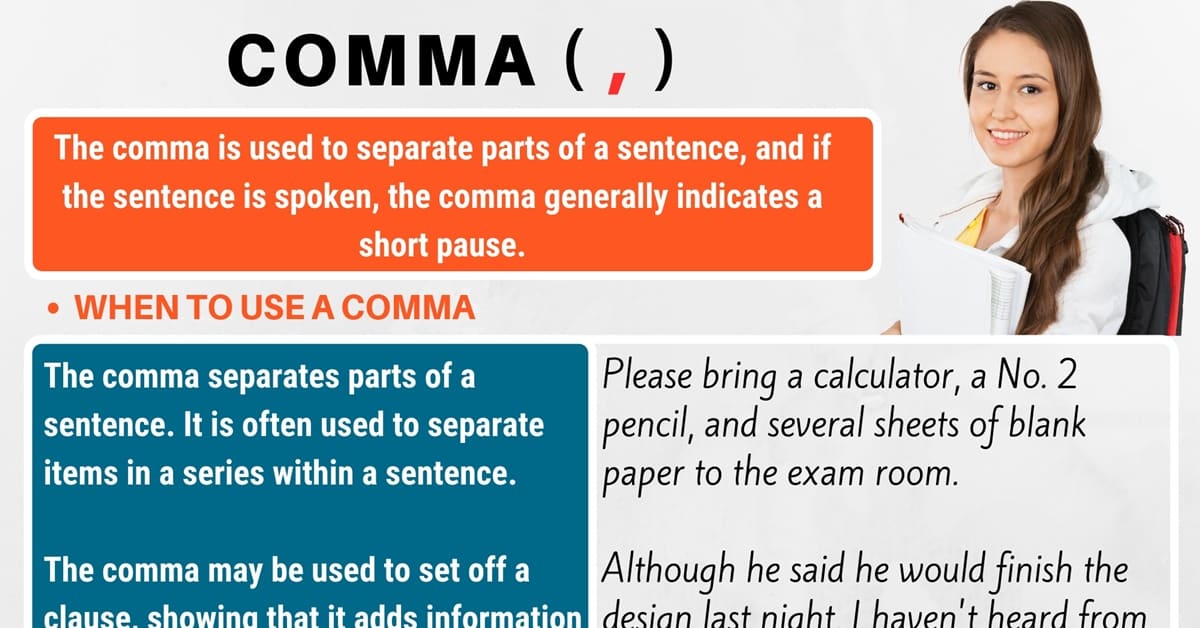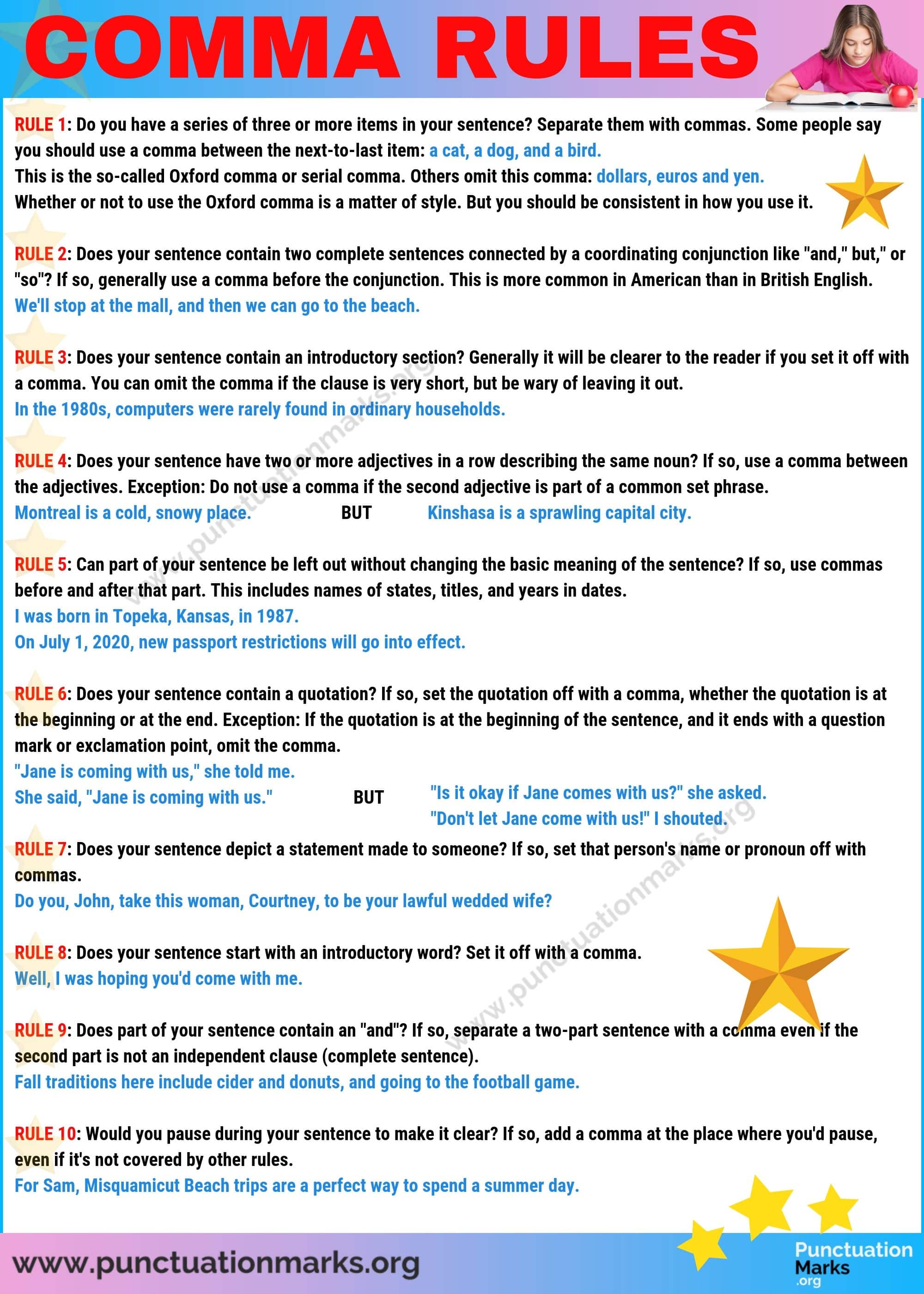Learn how and when to use commas (,) with comma rules in English. This punctuation mark is used to separate parts of a sentence, and if the sentence is spoken, the comma generally indicates a short pause.
Also, learn whether or not to use the Oxford comma with examples.
Table of Contents
The comma (,)
When to use a comma
The mark separates parts of a sentence. It is often used to separate items in a series within a sentence.
- Please bring a calculator, a No. 2 pencil, and several sheets of blank paper to the exam room.
- The main airlines flying the Tokyo-Jakarta route are Japan Airlines, ANA, and Garuda.
This punctuation mark may be used to set off a clause, showing that it adds information to the main body of the sentence.
- Although he said he would finish the design last night, I haven’t heard from him.
- She used to be the best writer we have, but lately her performance has declined.
If a subordinate clause appears in the middle of a sentence, use two commas to set it off. Omitting the second one is a common mistake.
- Atlanta, except between June and August, has a very pleasant climate.
Also, it is used in a sentence where someone is being addressed by name.
- Susan, would you bring me the book I was reading?
- I can’t believe you did that, Courtney!
What is the Oxford comma/serial comma?
The Oxford comma, also known as the serial comma, is the mark that may appear in a series before the “and” near the end of the sentence. Writers and editors disagree about whether it is necessary.
Examples with the Oxford comma:
- We’re going to visit Thailand, Vietnam, and Malaysia this summer.
- The ingredients of a martini are gin, vermouth, and an olive.
Examples without the Oxford comma:
- We’ll bring sandwiches, drinks and silverware to the party.
- The road to Buffalo goes through Utica, Syracuse and Rochester.
Neither method is right or wrong. Leaving out the serial comma can result in comically ambiguous sentences (“I’d like to thank my parents, my agent Elizabeth and God”), but in most cases such sentences can be rewritten.
How to use the comma with quotation marks
In American English, if you’re using quotation marks to show a quotation, put the mark (,) inside the closing quotation mark.
- “You’ll never be able to pass this course if you don’t start working hard now,” the professor told me.
- “Please collect your belongings and prepare to board the plane,” the flight attendant said.
In British English, the mark (,) goes outside the closing quotation mark.
- “Meet me at Trafalgar Square”, she said.
- “I’m ready when you are”, said my favourite shopping partner.
When to Use Commas | Infographic
Comma Rules
10 Useful Comma Rules
Learn ten rules for when to use the mark (,) in English with examples.
Rule #1
Do you have a series of three or more items in your sentence? Separate them with commas. Some people say you should use the mark (,) between the next-to-last item:
- a cat, a dog, and a bird
This is the so-called Oxford comma or serial comma. Others omit this comma: dollars, euros and yen
Whether or not to use the Oxford comma is a matter of style. But you should be consistent in how you use it.
Rule #2
Does your sentence contain two complete sentences connected by a coordinating conjunction like “and,” but,” or “so”? If so, generally use the mark (,) before the conjunction. This is more common in American than in British English.
- We’ll stop at the mall, and then we can go to the beach.
Rule #3
Does your sentence contain an introductory section? Generally it will be clearer to the reader if you set it off with a comma. You can omit the mark (,) if the clause is very short, but be wary of leaving it out.
- In the 1980s, computers were rarely found in ordinary households.
Rule #4
Does your sentence have two or more adjectives in a row describing the same noun? If so, use a comma between the adjectives. Exception: Do not use the mark (,) if the second adjective is part of a common set phrase.
- Montreal is a cold, snowy place.
BUT
- Kinshasa is a sprawling capital city.
Rule #5
Can part of your sentence be left out without changing the basic meaning of the sentence? If so, use the marks (,) before and after that part. This includes names of states, titles, and years in dates.
- St. Augustine, which is the oldest city in the United States, has many interesting tourist attractions.
- I was born in Topeka, Kansas, in 1987.
- On July 1, 2020, new passport restrictions will go into effect.
- Beverly Johnson, Ph.D., convened the meeting.
Rule #6
Does your sentence contain a quotation? If so, set the quotation off with a comma, whether the quotation is at the beginning or at the end. Exception: If the quotation is at the beginning of the sentence, and it ends with a question mark or exclamation point, omit the mark (,).
- “Jane is coming with us,” she told me.
- She said, “Jane is coming with us.”
BUT
- “Is it okay if Jane comes with us?” she asked.
- “Don’t let Jane come with us!” I shouted.
Rule #7
Does your sentence depict a statement made to someone? If so, set that person’s name or pronoun off with commas.
- Do you, John, take this woman, Courtney, to be your lawful wedded wife?
Rule #8
Does your sentence start with an introductory word? Set it off with the mark (,).
- Well, I was hoping you’d come with me.
Rule #9
Does part of your sentence contain an “and”? If so, separate a two-part sentence with a comma even if the second part is not an independent clause (complete sentence).
- Fall traditions here include cider and donuts, and going to the football game.
Rule #10
Would you pause during your sentence to make it clear? If so, add the mark (,) at the place where you’d pause, even if it’s not covered by other rules.
- For Sam, Misquamicut Beach trips are a perfect way to spend a summer day.




This helped to clear-up my confusion regarding the use of the comma.
Discucion de ingles